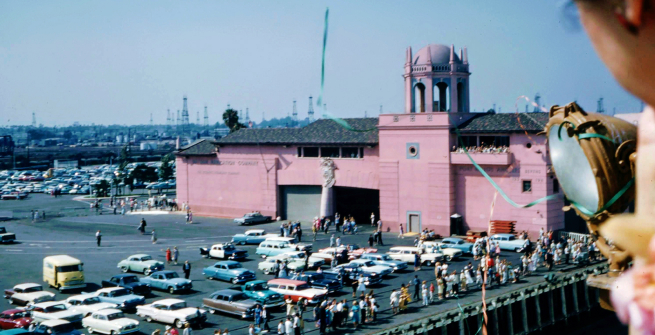It's a painful truth that Angelenos can much too easily identify architectural structures that have been erased from our city's landscape. Some structures are well-known and widely mourned while others have disappeared from our collective consciousness without much afterthought. Among the latter is a building that, despite the lucrative role it played in the growth of our city, was an unfortunate victim of the monster known as commercial redevelopment. When the building was unveiled to the world in 1953, its opening weekend attracted nearly 100,000 Angelenos who came to bask in the building's beauty and marvel at its space-age amenities. This building was touted as "the world's finest" not only by the Los Angeles city administration but by its tenant, a commercial titan who revolutionized business practices throughout the globe. By the end of the 1950s, nearly a million people had passed through its halls, among them Ronald Reagan, Walt Disney, and Elvis Presley. But the building served a much greater purpose than a celebrity hub; it was, in fact, a financial covenant between the City of Los Angeles and the (then) territory of Hawaii that wed the two in aesthetic and commercial matrimony. An abrupt (and unprecedented) pivot in interests, however, turned what was once an architectural shrine into something suited to a gothic novel as it sat forgotten, quite literally, at the edge of Los Angeles. In the interest of restoring some semblance of prestige to this lost landmark, let's take a look at this architectural marvel that occupied the Wilmington waterfront for more than thirty years before it vanished. Here is the story of the Matson Cruise Terminal.
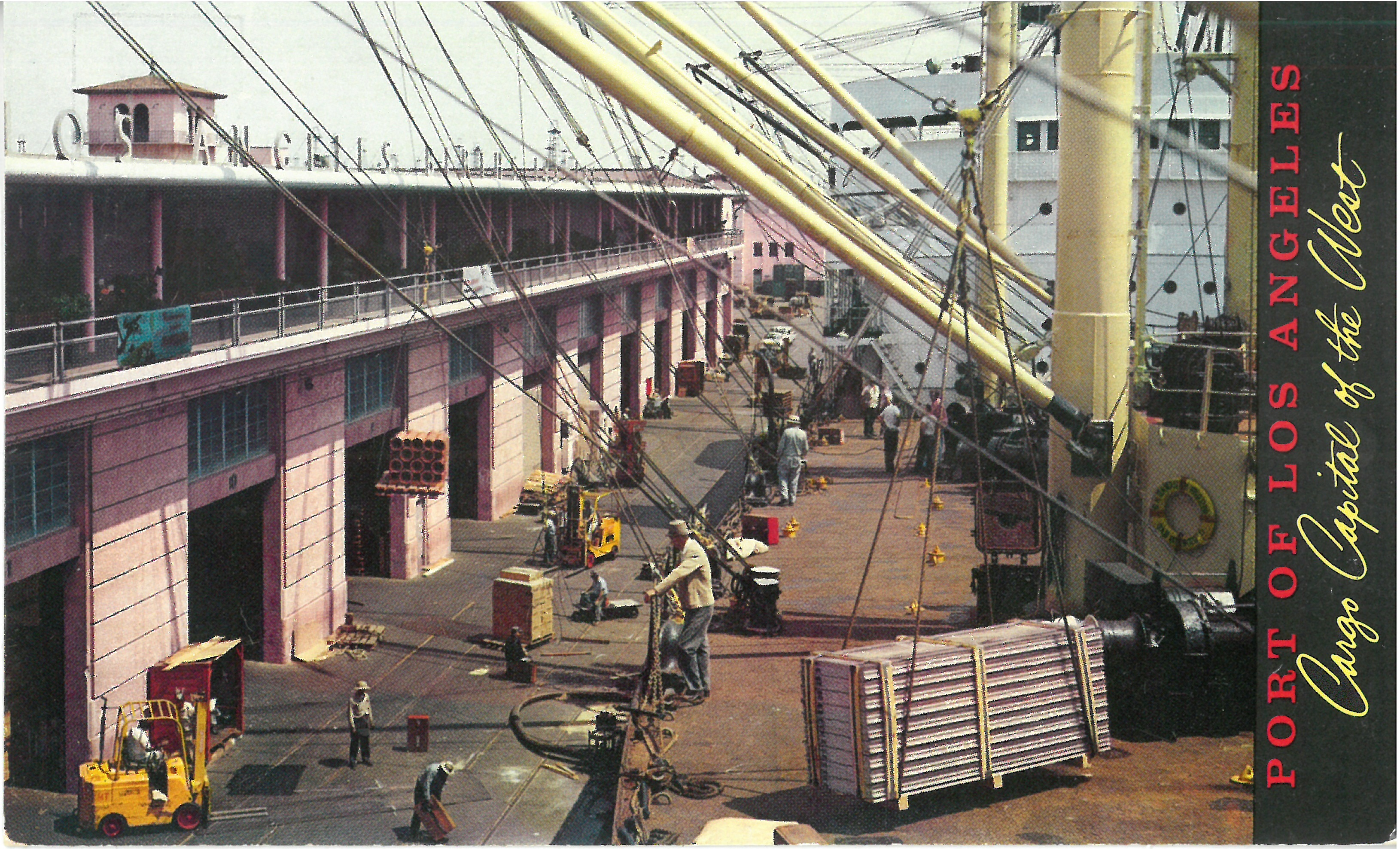
Driving along the 710 or 110 Freeways, chances are that you have seen a container truck with the word "Matson" emblazoned across it in blue letters. Matson Inc. has been involved with the transport of commercial goods for well over a century and has had a presence in the Los Angeles region for almost as long. Matson is a pioneer in the shipping industry and even has one of their early shipping containers housed at the Smithsonian Institution to prove it. Shipping, however, only played a small part in Matson's initial business ventures, a fact that has been obscured largely by the success of their contemporary operations. During the first half of the twentieth century, however, Matson was one of the leaders in commercial maritime travel, with a magnificent fleet of luxury ships to prove it. Presently, Matson calls the Port of Long Beach its home; however, the company used to operate out of the Port of Los Angeles and was responsible for much of the commercial travel within Los Angeles Harbor between 1910 and 1960. An economic boom in postwar America had created a stronger middle class with disposable income leading to an increase in patronage for Matson during the 1950s, a fact that the Los Angeles Harbor Department found impossible to ignore.

After WWII, the Los Angeles Harbor Department committed 25 million dollars to the revitalization of the waterfront. This redevelopment was centered on modernizing facilities but also included softening the reputation of the port by making it more inviting for families. One way this was achieved was by manufacturing community activities like the Fisherman's Fiesta and creating spaces like the Ports O' Call Village in San Pedro that would beckon more than just rough and tumble longshoremen. At the start of this revitalization, however, was a state-of-the-art passenger cruise terminal in Wilmington. The terminal would fulfill the Harbor Department's goal of creating a more people-friendly space by acting as a social center for families on their way to exotic destinations like Fiji, Tahiti, and Hawaii but it also stood as a venture to sweeten business relations between the Harbor Department and one of their most important tenants, Matson.
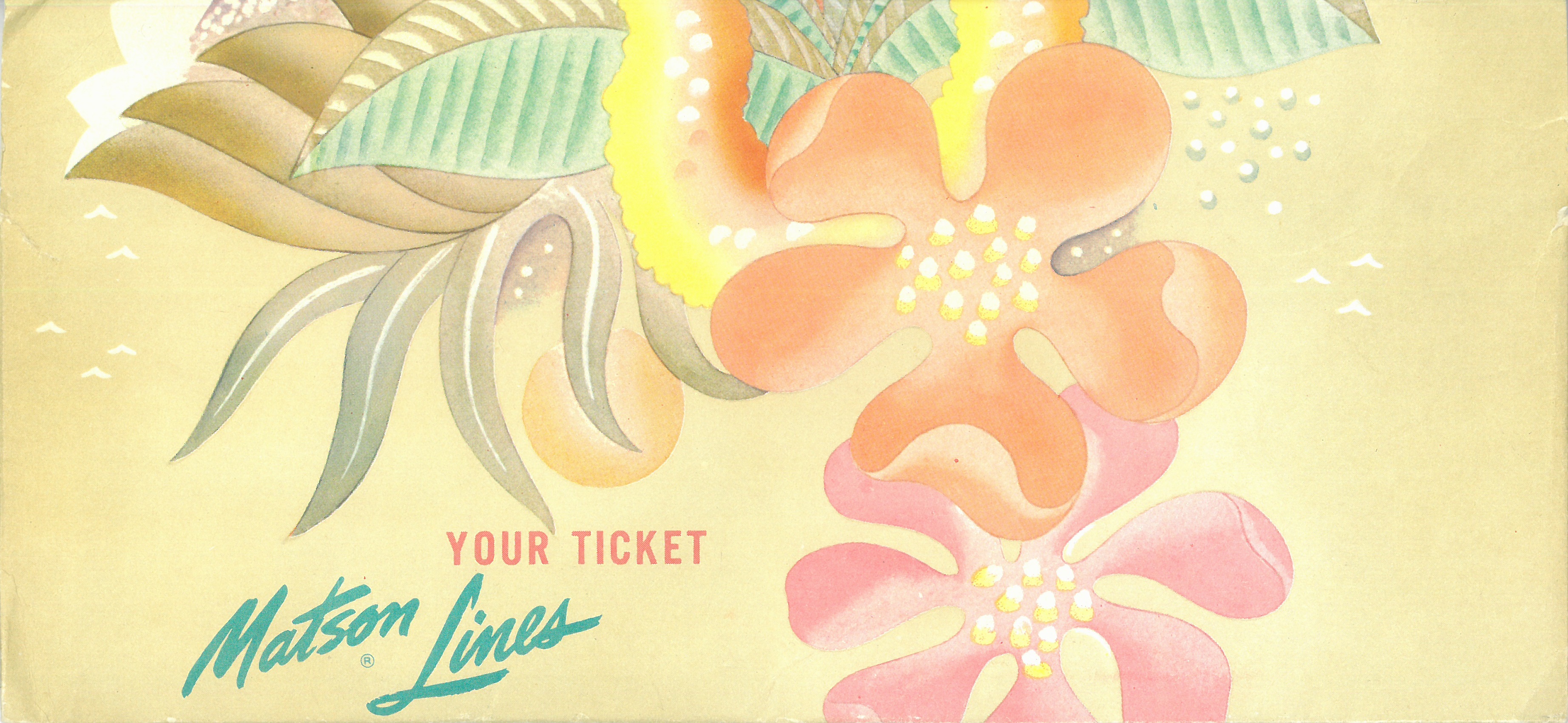
When complete, the Matson Terminal would occupy a total of 48 acres on a 1,649 ft. wharf along Wilmington's East Basin. It was an eight and a quarter-million-dollar undertaking that included the terminal, a 26-acre parking lot with the ability to handle up to 4,000 cars, an adjacent 200 ft. shed just northeast of the terminal, and a helipad. The terminal housed a plethora of what (at the time) were modern appliances like an escalator, an electric range in the kitchenette, and mechanized cargo amenities that eased the work of 1950s longshoremen, but it was the visual elements that made the real impression. Aesthetically speaking, the exterior stucco and terracotta played into Southern California's Spanish fantasy narrative and hearkened to architectural influences that were straight out of Moorish Spain. Of course, as a product of the 1950s, the building had a modern twist: the interior had a clean, efficient mid-century modern style that would rival any 1950s Palm Springs resort. The most striking feature of the terminal, however, was its color, a vivid pink, which made it impossible to ignore within the sea of white sun-baked stucco buildings dotting the waterfront. Although described as coral, the hue could shift from a delicate blush to a gaudy Jayne Mansfield pink depending on the amount of sunlight it was exposed to. The color, however, wasn't the result of a 2-for-1 paint sale and, much like its Mediterranean-inspired aesthetic, the choice was intentional and meant to bridge a familial link to a "royal" relative.
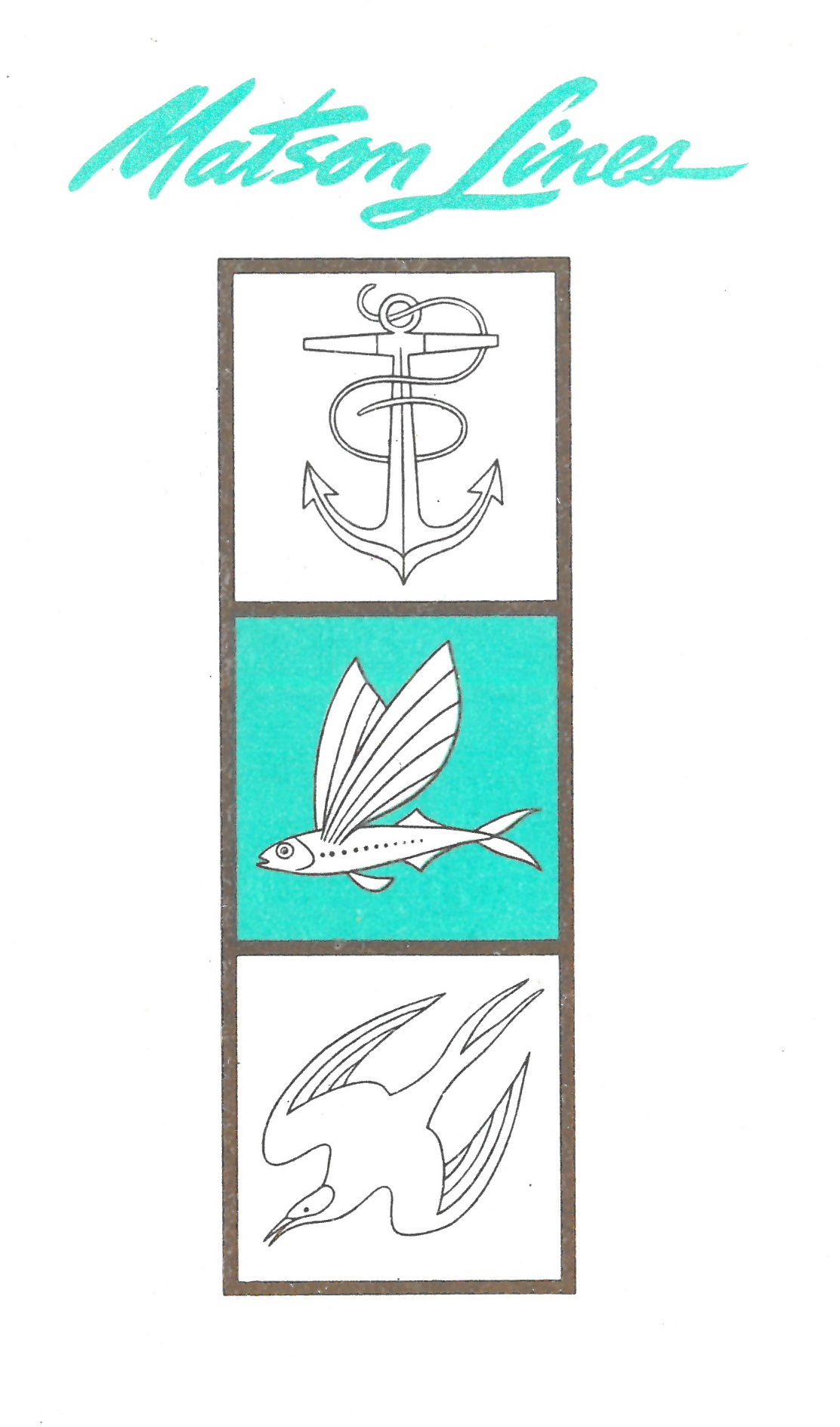
A “Royal” Connection
Hawaii's economic prosperity was beginning to ripen in the aftermath of WWI, and Matson played an integral part in that success. In addition to investing in a fleet of luxury cruise liners, Matson had also invested in a number of resort hotels in Hawaii, including the Royal Hawaiian Hotel at Waikiki Beach. Matson was one of the initial investors in the four million dollar property (completed in 1927), and by 1941, Matson had expanded their business interests to assume full control over the management of the Royal Hawaiian. Matson would acquire additional hotels on Waikiki Beach, including the Princess Kaiulani, Moana, and Surf Rider, and, by 1955, more than half of the tourists visiting Hawaii were staying at a Matson property. The Royal Hawaiian, however, was the crown jewel in Matson's resort holdings, earning the nickname the "Pink Palace of the Pacific." The hotel's architectural style eschewed the colonial styles that were ubiquitous on the islands, opting for a Mediterranean aesthetic instead. According to author Stan Cohen, the choice to design the Royal Hawaiian in a Moorish/Mediterranean style was influenced largely by the popularity of Rudolph Valentino movies and the ersatz Spain that was created on a Hollywood backlot. The style not only made it unique, but the color, a bright pink, made the hotel pop out against the wall of resorts lining Waikiki Beach. Matson continued to operate the Royal Hawaiian until 1959, when it began moving away from managing resorts and focusing solely on passenger services and shipping ventures. In replicating the Mediterranean style and coral tint, the Harbor Department architects were deliberately drawing both an aesthetic and brand connection to the hotel, which, by 1953, had become a universally recognized landmark.
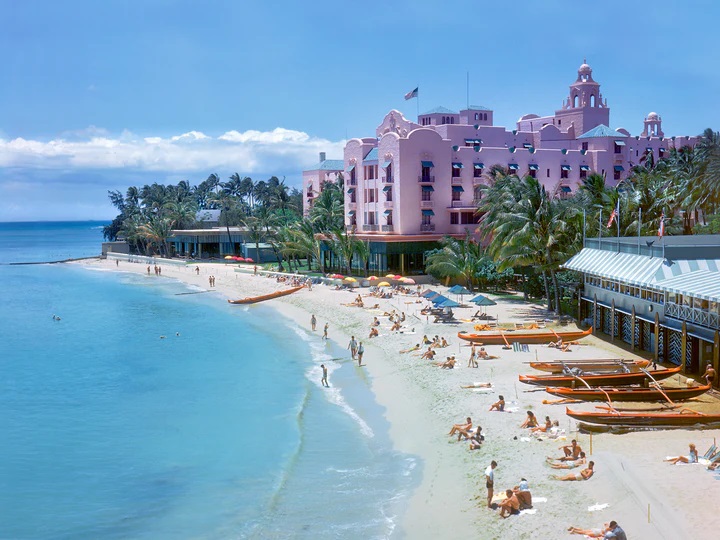
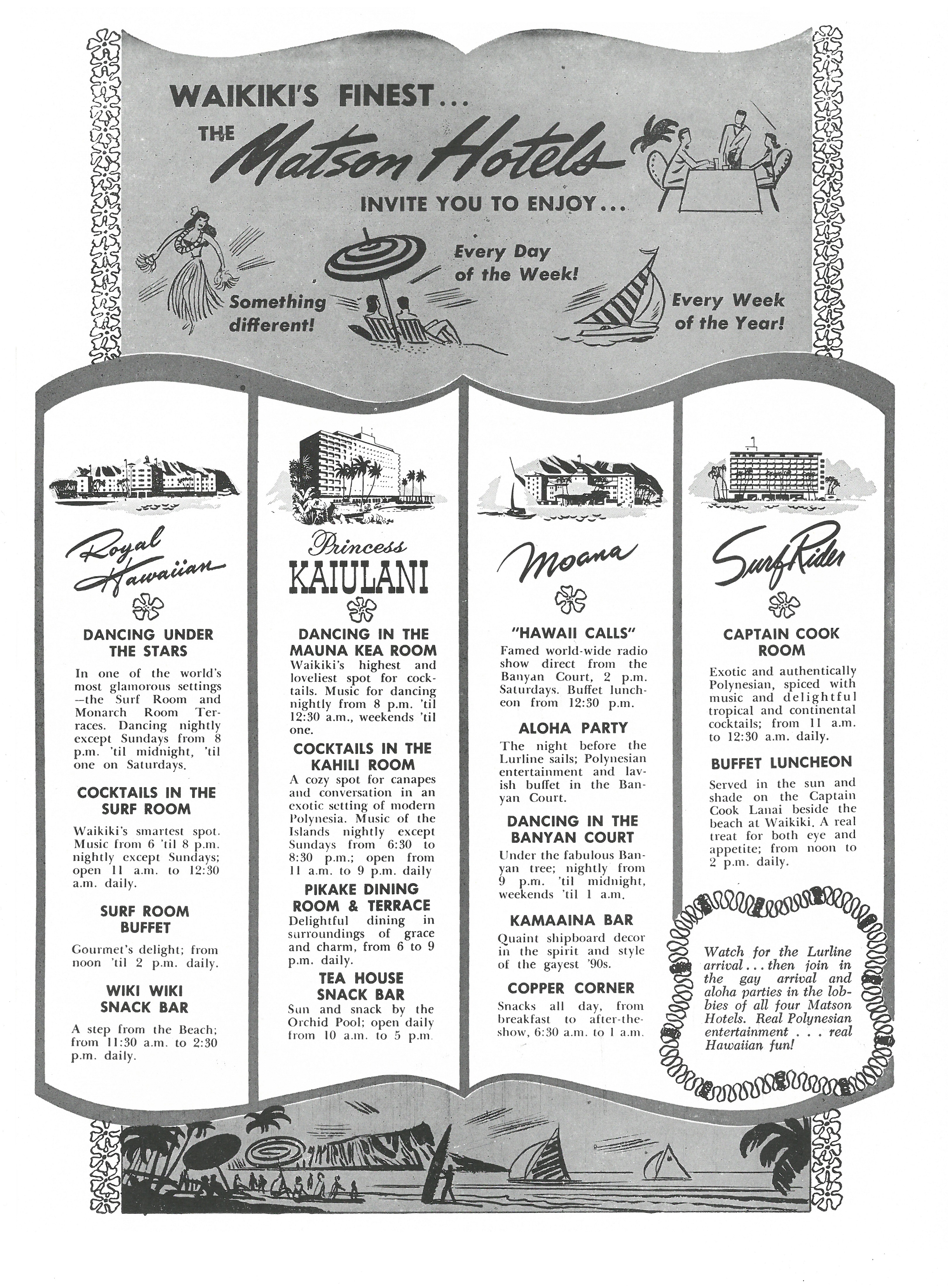

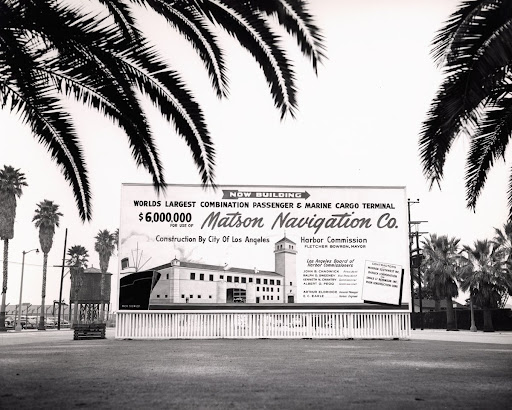
Burgo Purcell’s Bali Hai
Burgo Purcell was the principal architect associated with the Matson Terminal. Purcell was born and raised in San Gabriel but moved to San Pedro, where he worked for the Los Angeles Harbor Department for nine years. Prior to the terminal's opening, Purcell was interviewed by the Wilmington Daily Journal to explain the building's style and what that style was meant to convey to visitors. He explained that he purposely chose not to design in design styles that were becoming ubiquitous throughout Los Angeles: "It is perhaps surprising that little evidence of contemporary design is to be found in the new terminal, especially in this day when public buildings, almost without exception, are worked out in what is sometimes called the international style, as opposed to traditional expressions" Purcell explained that the choice to design a building that would complement the Royal Hawaiian was more than pandering to Matson Navigation, it was a methodical choice that would play into the larger travel "experience" for passengers; moreover, Purcell reasoned that it was rooted in romanticism:
"We know that most travelers leaving Los Angeles Harbor have dreams of sailing away to an island of the Pacific where everything will be perfect. The Bali Hai of their imagination. We thought that maybe their romantic adventure might, and could well, begin in a setting itself not without color and romance...the ceramic friezes and wrought iron, the gay colors, the coral walls, the clock tower with chimes…"
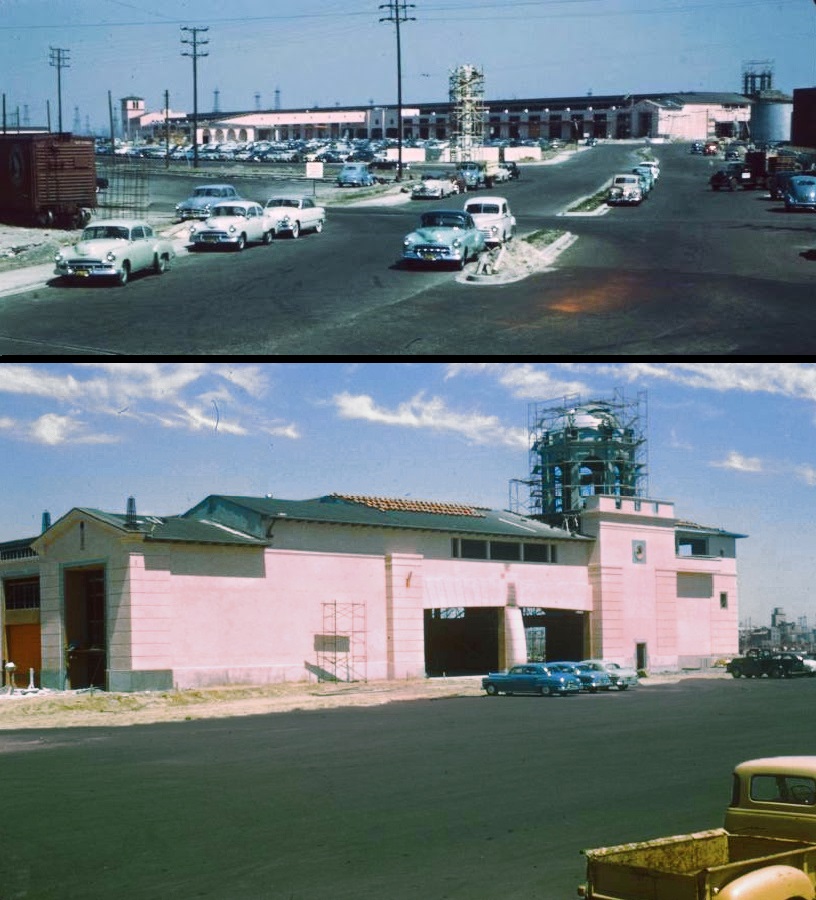
Construction began sometime in 1952, but the first mention of the Matson Terminal in the Harbor Commission meeting minutes occurred in mid-1950 while still in the planning stages. On June 28, 1950, the Matson Company made an inquiry with Los Angeles Harbor General Manager, Arthur Eldridge, to see if it was possible to construct a helipad at the site. Matson personnel cited Los Angeles Times reports that indicated helicopter taxi services were on the verge of booming, and constructing a landing pad "would be a step forward and in keeping with increased development in this type of service." To keep Matson happy, a helipad was built, and while it played an important role in the opening weekend ceremonies, it's not clear how much use it received beyond that.
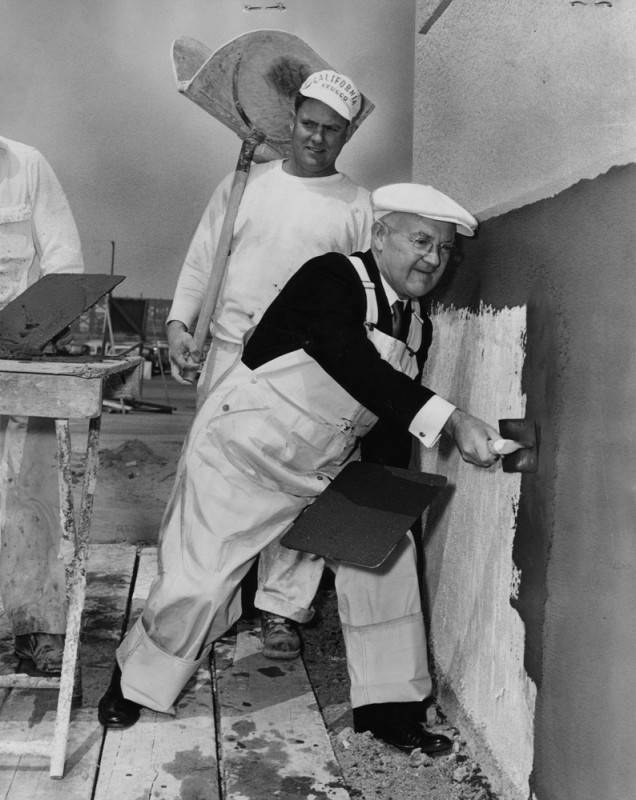
Visitors driving in from Wilmington were aware they were approaching the terminal by the statuary lining the entrance. The six-lane entrance/exit was separated by a median that housed an ornate wrought iron sculpture topped with a pineapple, a fruit symbolic of Hawaii. Cement pillars with nautical ornamentation flanked opposite sides of the street and were capped with fin-shaped frosted glass lights. The only visual obstruction between the visitor driving in and the terminal was a circular planter that served as a roundabout for vehicles exiting the property. The west façade of the building at Berth 195 was the main entrance for the public, and it was astounding. A massive cupola crowned the three-story structure demanding attention from all who set foot on this corner of the waterfront. The top floor of the terminal served as a waiting area that allowed both passengers and visitors seeing them off to interact. Along the terminal's southern edge was a 120-foot concourse that overlooked the East Channel. The concourse allowed passengers to greet arrivals or bid loved ones adieu as they departed Los Angeles Harbor. West of the concourse, a balcony overlooking the public entrance provided visitors with a view of the waterfront and the cement balustrade that acted as a barrier between the dock and the water. The balustrade joined elaborate 9-foot cement urns that were capped with a wreath of garland sitting immediately underneath the lip. Ferocious-looking lion heads flanked the urns at the handles. The marriage of the Matson Navigation Company and The Port of Los Angeles was immediately evident by the massive silver lettering that stood in contrast to the vibrant pink stucco.
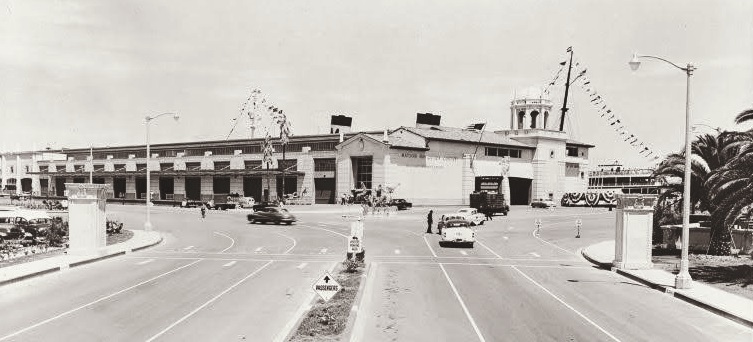
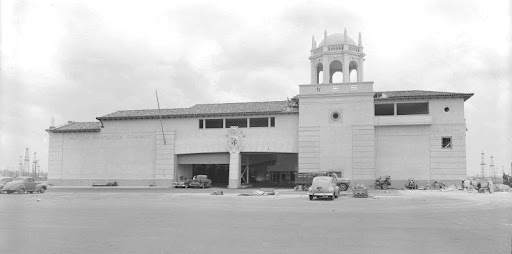

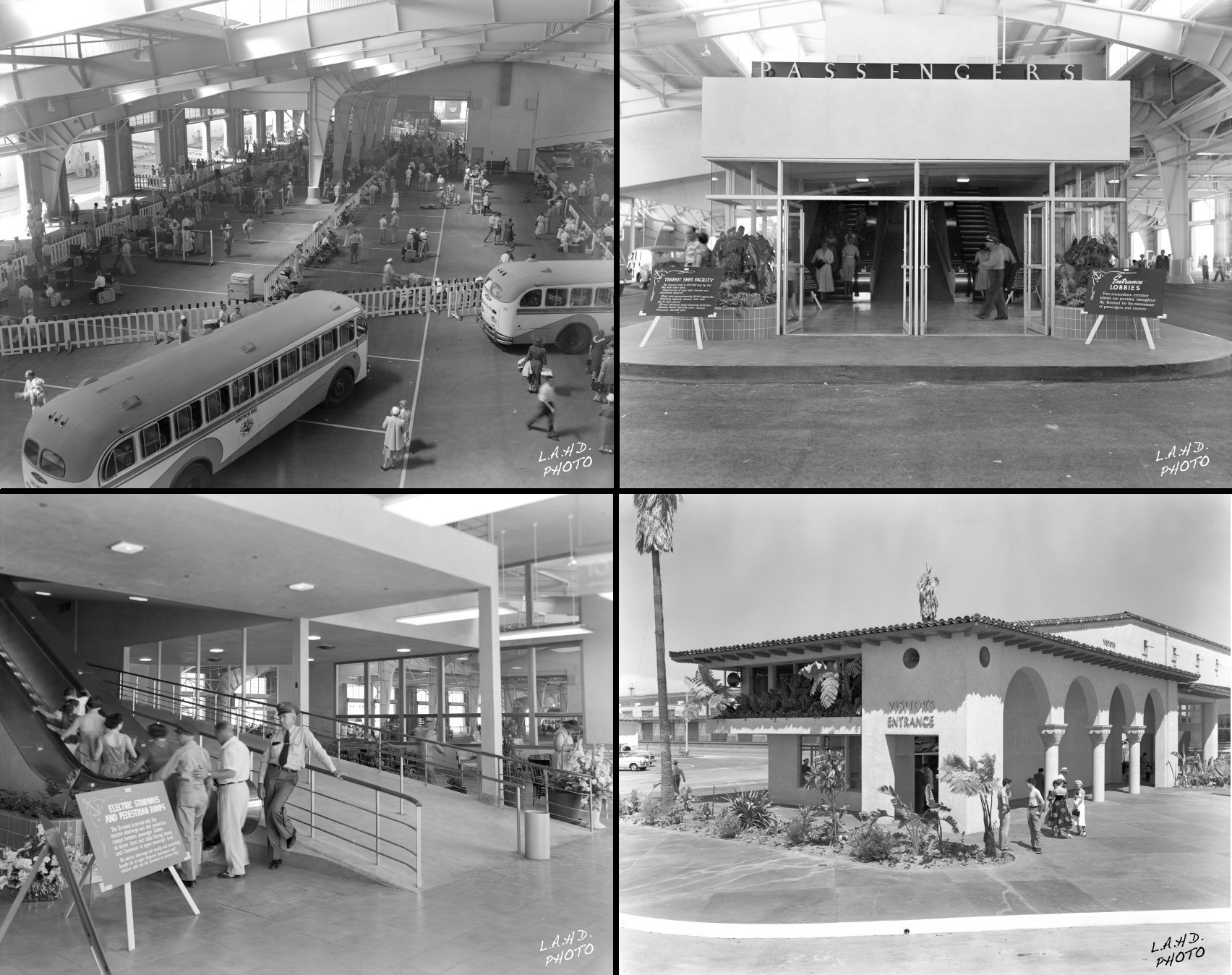
Matson's business offices sat at the opposite end of the terminal at Berth 198. The entrance to the offices was at the foot of an imposing clock tower at the northeast corner of the building while an escalator (or elevator) ushered employees to the top two floors where Matson's workforce toiled. Harbor Department literature detailed the (slightly) less glamorous yet highly functional interior: "all offices and hallways are finished with acoustical tile ceilings, linoleum floors, including counters, ventilating steel sash with Venetian blinds and fluorescent lighting fixtures. In the mezzanine area, a service room, fully equipped with electrical appliances for every need, has been provided for the use of office personnel, where light lunches may be prepared and served." The secretarial pool presented nothing unexpected; however, the kitchenette seemed to be a point of obsession to everyone who stepped foot inside the building. Local reporters and Harbor Department photographers seemed overly invested in photographing Matson's female workforce near the stovetop, oven, and dishwasher. Sexist scenarios aside, the appliances were, in fact, state of the art and something rarely seen in residential homes; as one Matson employee put it, "home was never like this!" At the end of the day, Matson was a business that, in conjunction with the Los Angeles Harbor Department, was now poised to present the new terminal to the public in a three-day celebration that should have been impossible to forget.
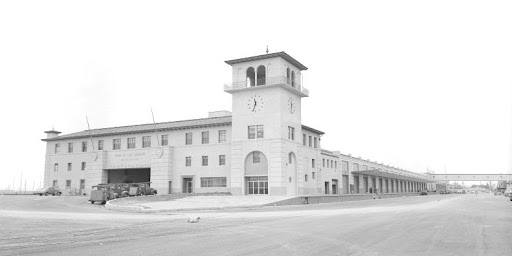
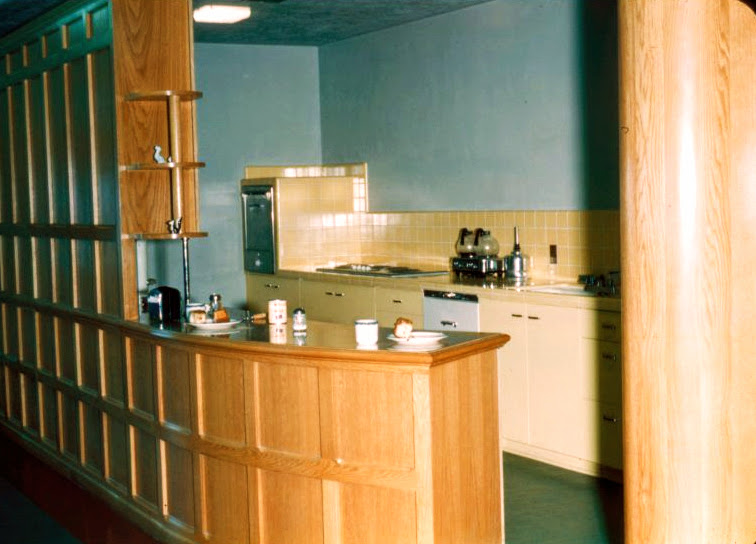
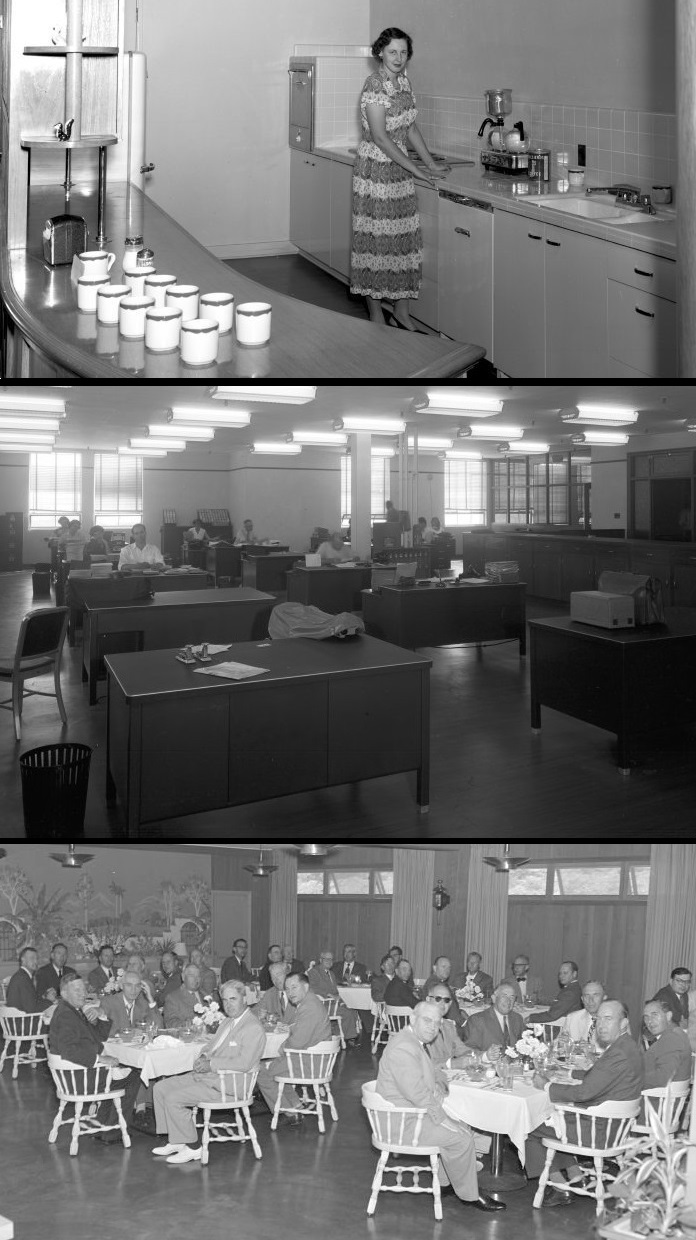
Dedication Weekend


Dedication ceremonies took place the weekend of July 11-13, 1953, and were given all the pomp and circumstance that would normally be afforded visiting dignitaries. The Times reported that 23-year-old University of Hawaii student and Miss Hawaii contestant, Virginia Tibbetts, acted as "official hostess" of that weekend's events. Dubbed "the Matson Girl," Tibbetts had been hired as Matson's official spokesmodel and acted as the face of the company. Tibbetts was on board Matson's Lurline so often during the early 1950s that it might as well have been a second home to the Hawaii native. The arrival of the Lurline was intended as the official opening of the terminal, and Tibbetts was charged with catching the first line tossed from the ship, tying it to the dock, and greeting first arrivals. Two different people have been reported as the first to step off the ship that day. The Wilmington Daily Journal identified the lucky passenger as actress Joan Davis while the Los Angeles Examiner said it was Mr. & Mrs. Frank Caulk of Riverside. Tibbetts then led harbor commissioners, Matson representatives, and L.A. City bigwigs on a tour through the facility. Papers reported that the dedication was intended to coincide with the centennial of Phineas Banning's "founding" of Los Angeles Harbor, which may have explained why Tibbetts "dramatized the development of Los Angeles Harbor from a virtual mudflat to one of the world's finest ports" through a traditional hula dance. The Times went on to dub Tibbetts the "Mermaid of Los Angeles Harbor" and explained that her duties for this weekend had only just begun. The following day, July 12, Tibbetts was scheduled to return to the Terminal in the most dramatic fashion imaginable at the time. Matson's mermaid was about to fly.

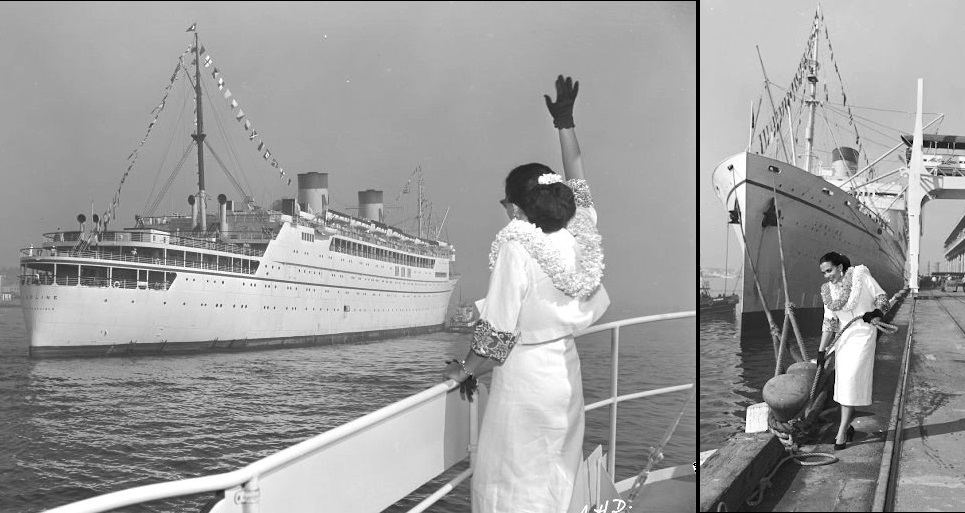
The morning of Sunday, July 12, 1953, Tibbetts and the entertainment director of the S.S. Lurline, Howard K Morris, arrived at the terminal via the Los Angeles Airways Inc. taxi helicopter, which had shuttled the pair in from LAX. It was a dramatic way to introduce the new service that Matson officials had requested in the final design of the terminal three years earlier. The terminal was open for public inspection beginning at 9 a.m., and at noon, the Lurline opened for public viewing, allowing prospective tourists to admire Matson's finest vessel.
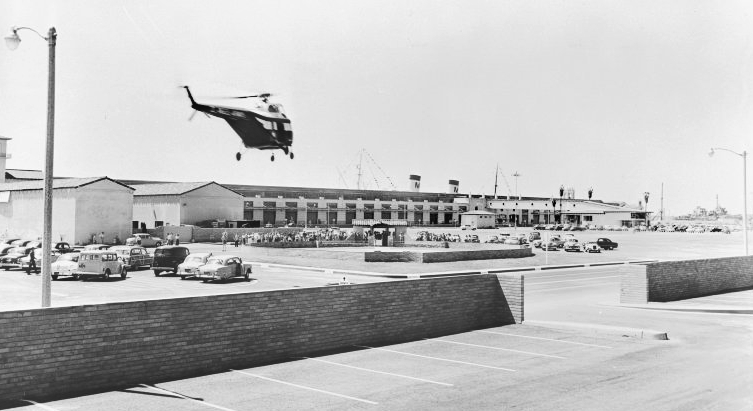
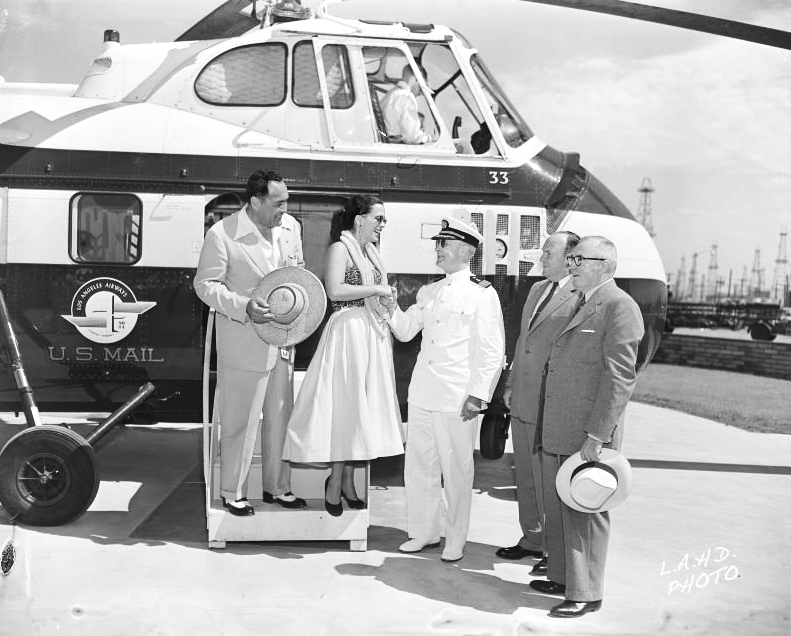
The following day, Monday, July 13, 1953, was the official dedication day of the new terminal. A raised platform was constructed outside the entrance at Berth 195 for the dedication ceremony. Red, white and blue bunting was draped over every inch of the banister, and flag poles were erected to coincide with a flag-raising ceremony. The dedication ceremony took place on the raised platform outside the public entrance, and ceremonies started at 10:30 a.m. with the biggest publicity stunt of the entire weekend: a long-distance phone call from Vice President Richard M. Nixon on a gold telephone. The phone call was supposed to be received by newly elected Mayor Norris Poulson, but reports stated that he was out of town, necessitating San Pedro councilman John S. Gibson to step in instead. There was a mention in the papers that a congratulatory telegram from President Dwight D. Eisenhower was supposed to be read shortly after Nixon's phone call, but no word if that actually happened. Vocalist Dennis Day took the stage and sang the Star-Spangled Banner while music was performed by the Camp Pendleton Marine Post Band. The interests of the United States, California, Matson Navigation, the City of Los Angeles, and the Harbor Department were all represented in the form of robust new flags that were each raised by a sailor, a soldier, a policeman, a Marine, and Tibbetts. Speeches were then given in tandem by California Lt. Governor Goodwin Knight, Charles S. Thomas (Undersecretary of the Navy), Randolph Sevier (President of Matson Navigation Company), Albert O. Pegg (Harbor Commission President), and Farrant L. Turner (Secretary of the Territory of Hawaii prior to its statehood six years later). Ceremonies concluded at 4 p.m. with the departure of the Lurline for Hawaii. Among the passengers for the return trip was Miss Virginia Tibbetts of Honolulu, who was headed home after a very long weekend. Local papers explained that 100,000 people had visited the terminal during dedication weekend.
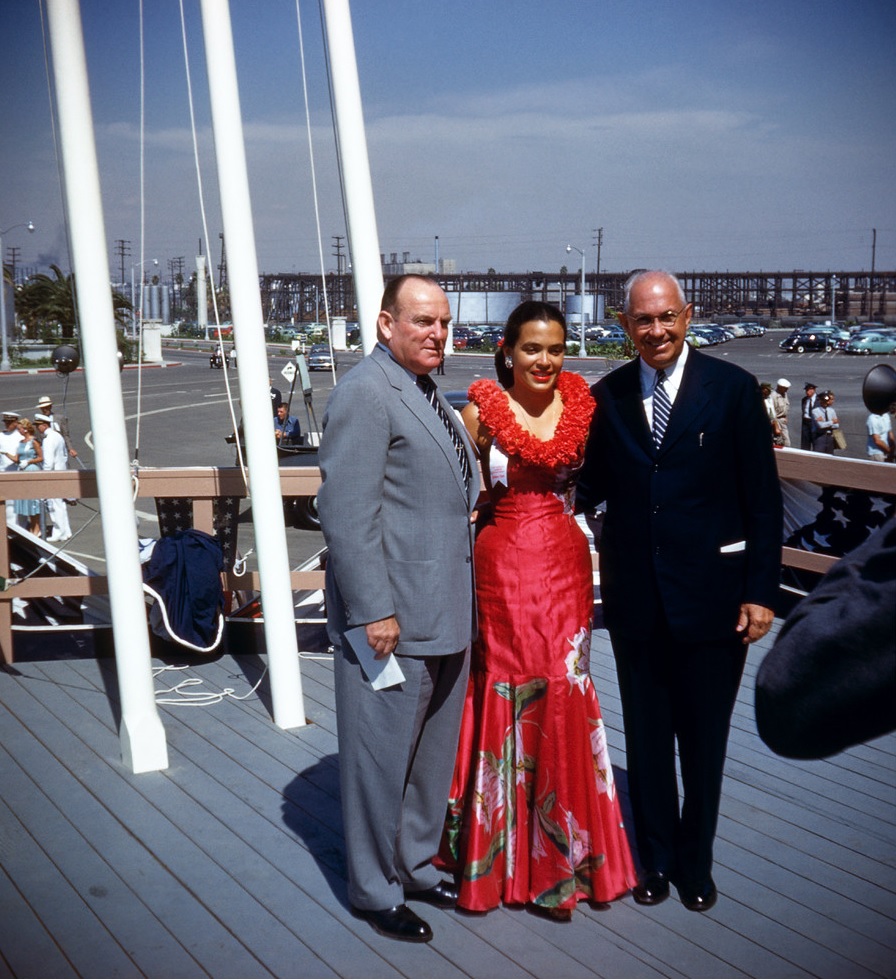

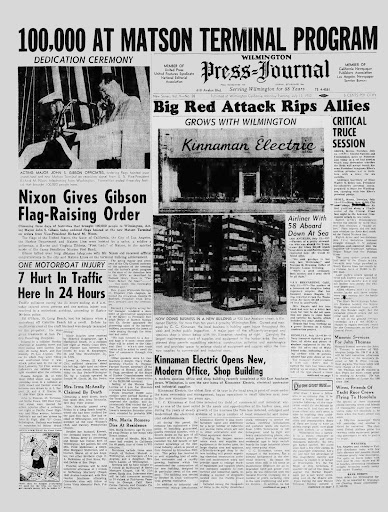
Shortly after the ceremonies, Randolph Sevier, President of Matson Navigation Company, sent a letter to the Harbor Commission expressing gratitude for the festivities and the Matson organization's continued enthusiasm regarding future exchanges: "The new terminal is an outstanding accomplishment and a truly great facility. There is every reason to believe that it will act as a magnet drawing new business and commerce to the area and through the port. Inquiries we have had to date are evidence of that, and we have already started the development of a program to capitalize on this advantage…"
"A Bigger and Better Wilmington"
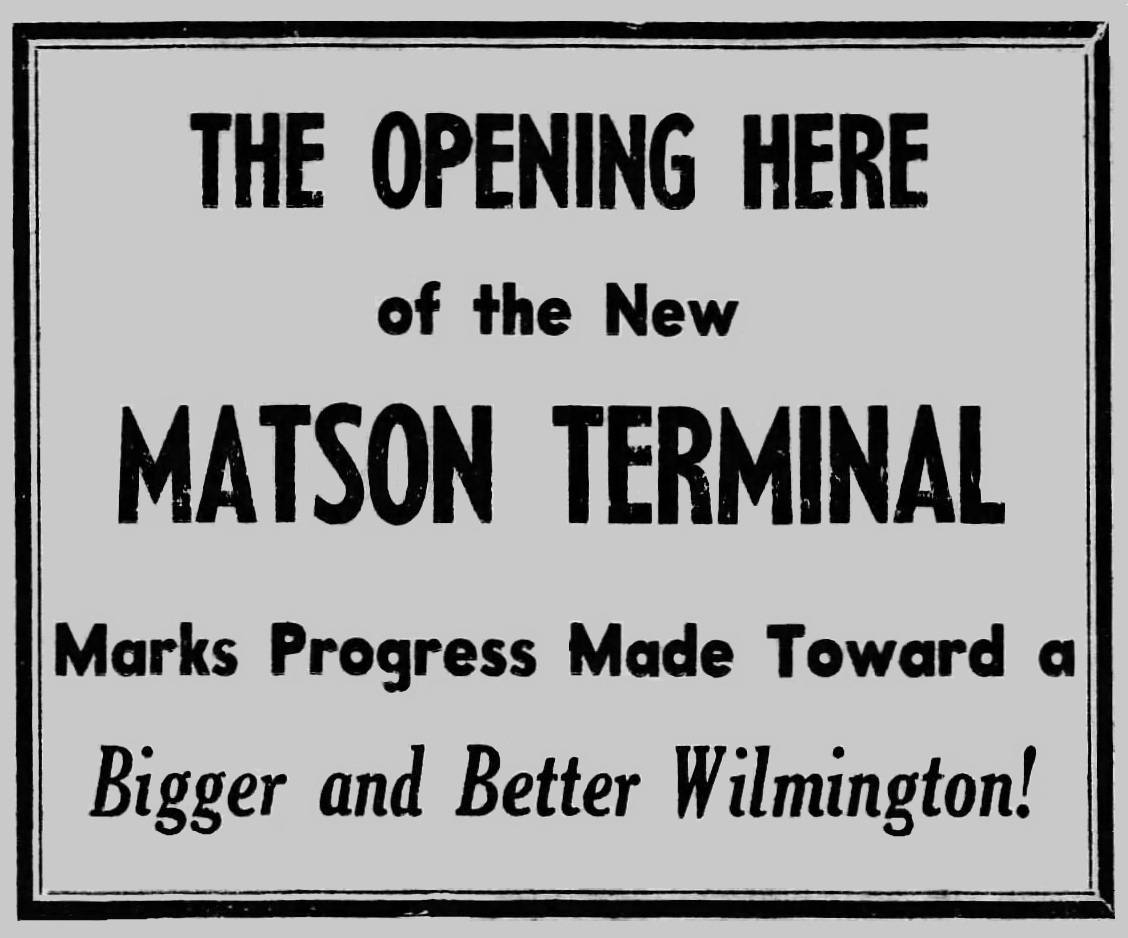
Wilmington seemed to immediately claim the terminal as its own, and it became a source of civic pride. The rush of income that WWII shipbuilding industry had brought to one of Los Angeles' oldest neighborhoods was effectively over, but the Harbor Department, local businesses, and civic organizations were certain that Matson could help revive Wilmington's economy. The local paper, The Wilmington Daily Journal, devoted nearly half of the July 10 issue to coverage of the impending festivities, and nearly every small business in the area took out ads to relay congratulations while similar congratulatory ads could be found throughout larger papers like the Times and the Herald. The prevailing tagline throughout these ads was typically that the terminal would contribute to "a bigger and better Wilmington." The front page headline that day read "Shipping World Looks to Wilmington," while the subsequent article, drenched in McCarthy-era patriotism, stated that "to be the first in the community, the nation or the world in anything constructive is a proud distinction. Today Wilmington stands first in the entire world in the field of marine terminals...both Matson and Los Angeles Harbor are symbols in their progress of Americanism at its best...histories both are chaptered with many struggles and problems which are overcome in the American way. Be proud Wilmington!" The transnational reputation of Matson ensured that attention was fixed on one of L.A.'s oldest neighborhoods, while the terminal itself created a steady stream of patronage to local businesses. Wilmington, after all, was the last stop for incidentals before a long voyage, and people could easily kill time in local shops or diners if they happened to arrive early.

The terminal also functioned as a community hub. Most employees working at the terminal were locals so it became a space for employee events like regional company "picnics" and more intimate gatherings like the 1957 retirement party thrown for Matson regional manager James A. Jackson. A 1957 article in the Japanese American newspaper Rafu Shimpo illustrated that the Matson Terminal was also a place for the community to welcome important travelers, such as the time when a troupe of Girl Scouts visited the terminal to welcome Mother Mary Columba of the Maryknoll Sisters. The girls serenaded Columba following the nun's return from visiting Catholic missions around the world. The building was a rendezvous point for events like Harbor Day (a springtime boat/land pageant for locals), assorted boat races, and was a touchstone for maritime tours of San Pedro Bay.
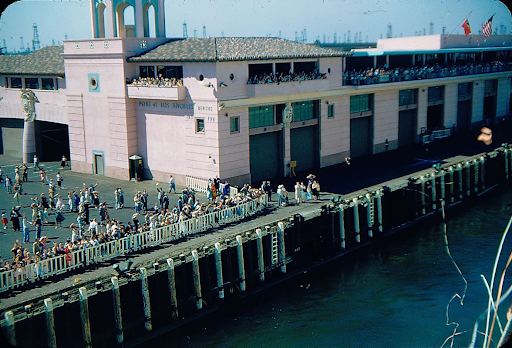
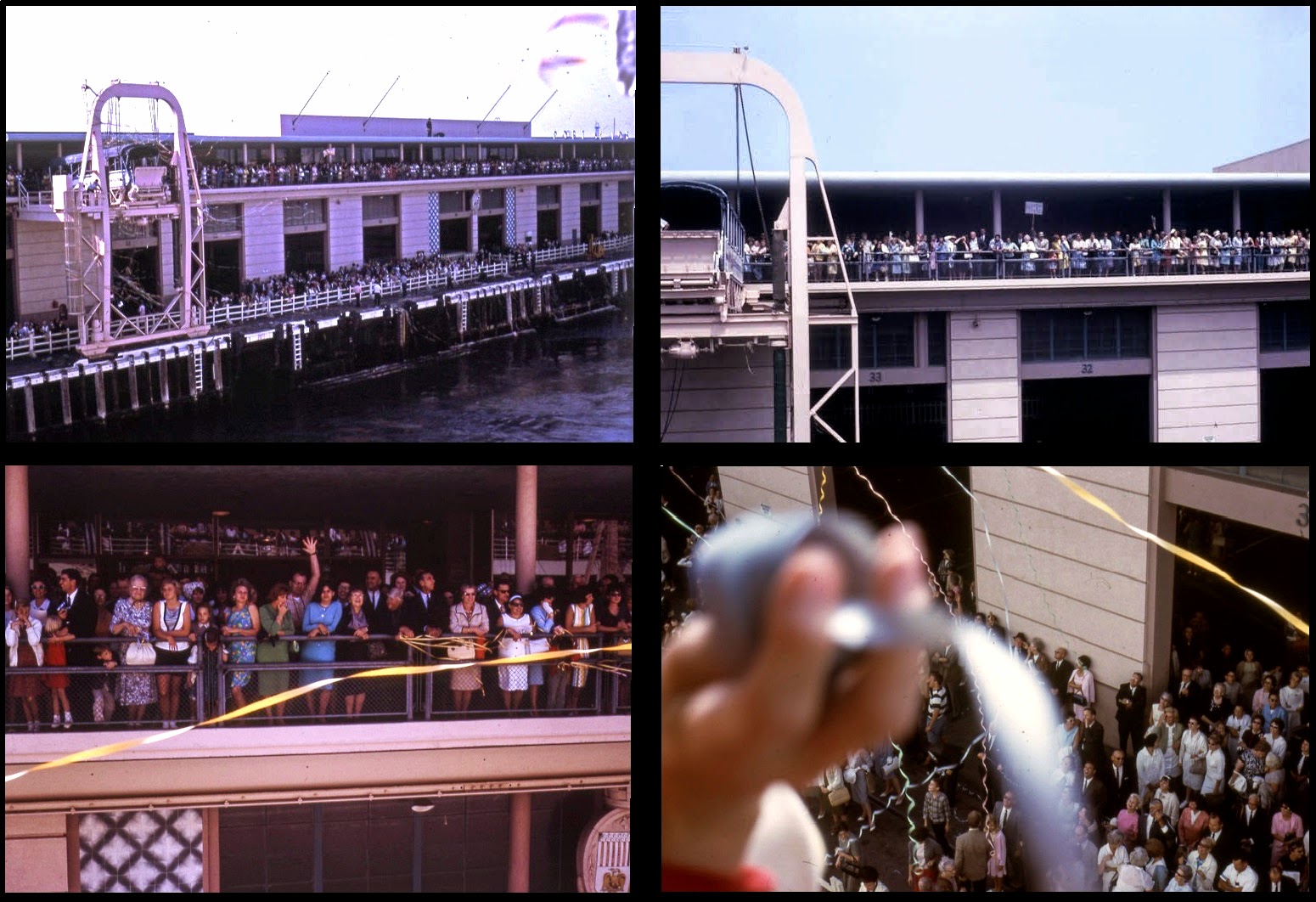
The terminal evolved into a consulate of sorts for City officials to exhibit the Port's maritime prowess and display the aesthetic and technological advancements within the building to world diplomats. One 1955 Wilmington Daily Press Journal article, for example, reported that a group of Indian government officials led by G.R. Kadapa, an official described as a "port administrative officer for the Government of India" was rightfully in awe of the terminal, describing it simply as "amazing." But showing the terminal off wasn't limited to maritime officials. Local papers would periodically feature stories about foreign dignitaries who were escorted through the Matson Terminal in conjunction with their visits. One 1957 Rafu Shimpo article, for example, explained that Japanese Government officials were given VIP tours of the terminal by L.A. Mayor Norris Poulson and Councilman John Gibson as part of their visit to Los Angeles. Business continued to thrive well into the late 1960s, and the terminal played an important part in Harbor Department publicity throughout the late 1950s, appearing on ephemeral material such as postcards, matchbooks, and the cover of the 1958-1959 Harbor Department Annual Report. Wilmington's pink palace never failed to impress anyone who saw it and was truly a source of pride across the social strata of Los Angeles. This maritime embassy arrived, however, at what turned out to be a thoroughly inopportune moment. As the sixties came to a close, the terminal's occupant was about to make some dramatic changes to their operations.
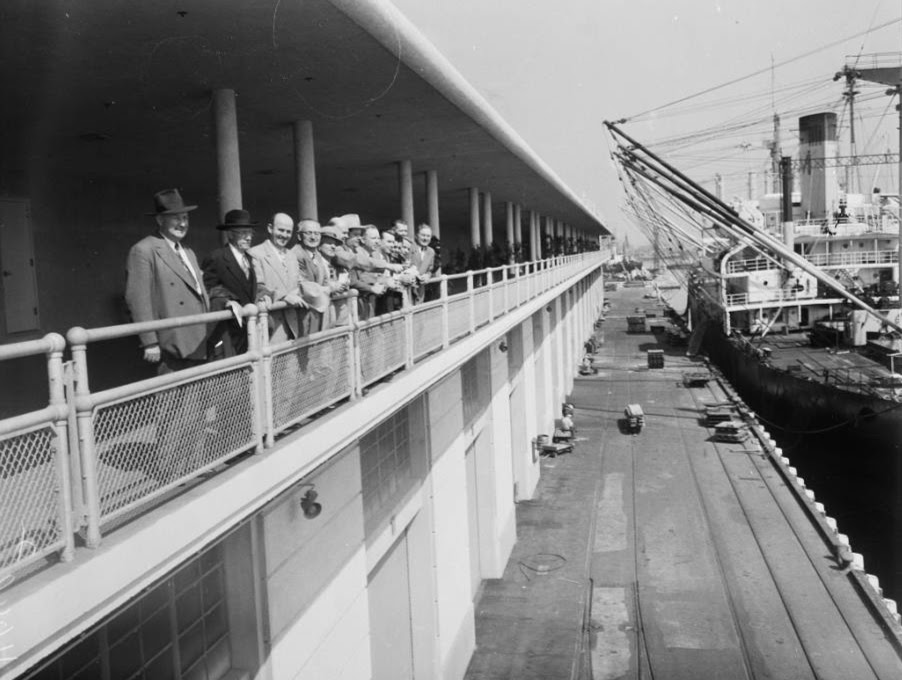
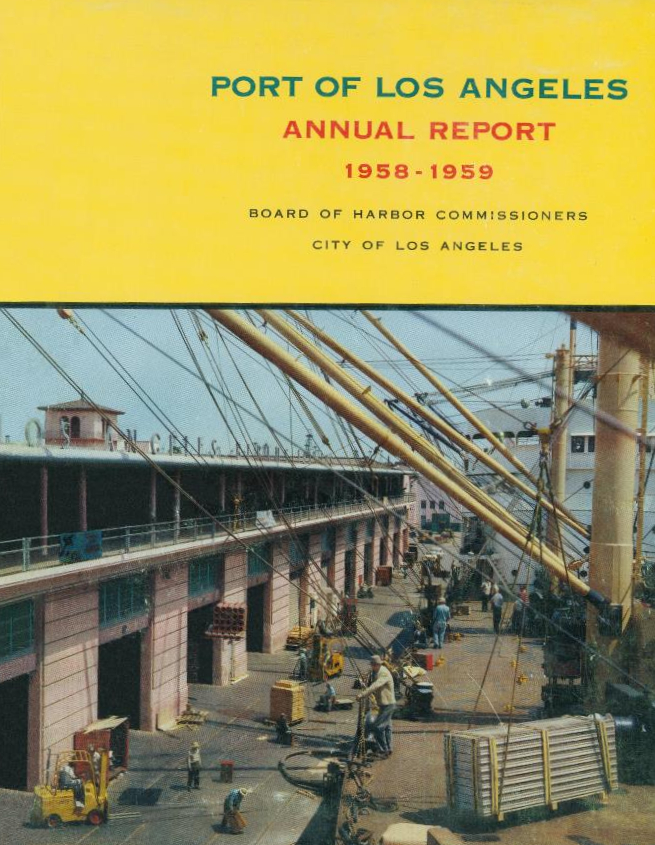
Cruise line passenger services are popular; however, passenger numbers have fallen dramatically since the first half of the twentieth century, when they were at their peak. By the start of the 1960s, air travel was proving to be both faster and an increasingly affordable alternative, leading many passengers to forgo a ship as a means of travel. Moreover, the 4 ½ day trip it took to travel both to and from the Hawaiian Islands via ship seemed painfully long when compared to a plane that could get there in a matter of hours. Air travel had also improved dramatically since WWII and now had amenities like pressurized cabins and reclining seats. Matson Inc., feeling this shift, began to focus on container shipping, even opening a container yard on the other side of the east basin on Terminal Island. Matson eventually sold the Royal Hawaiian in 1959 but maintained cruise services for nearly a decade when in 1970, Matson dropped a bombshell on the maritime world. Matson officials announced they were withdrawing from passenger services altogether. Not only would the terminal lose its patron, but Matson's withdrawal was the penultimate disconnect from the terminal's aesthetic parent, the Royal Hawaiian hotel.

At the Port of Los Angeles, the Harbor Department did something in the early 1960s that, at the time, seemed inconsequential but, in a few years, would spell disaster for the Matson Terminal. In 1963, the Harbor Department built a second cruise terminal in San Pedro for American President Lines (APL), only ten years after the Matson Terminal was complete. APL's success rivaled Matson and, given the postwar boom in commercial travel, building a second terminal didn't seem like a bad decision, it seemed like a smart one. This time the services of renowned local architect Edward Fickett were called upon to design a modern terminal that had nearly identical amenities to Matson's. Like the Matson Terminal, the new APL World Cruise Terminal also featured a mid-century modern interior, but, unlike Matson, the exterior was also a mid-century modern design, something that, for a while at least, got a lot of attention. Like Matson, APL eventually moved away from commercial travel services in favor of shipping leaving the World Cruise Terminal orphaned as well. Commercial cruise line services at the Port of Los Angeles didn't end, of course, but there was certainly not enough traffic to maintain two cruise terminals.
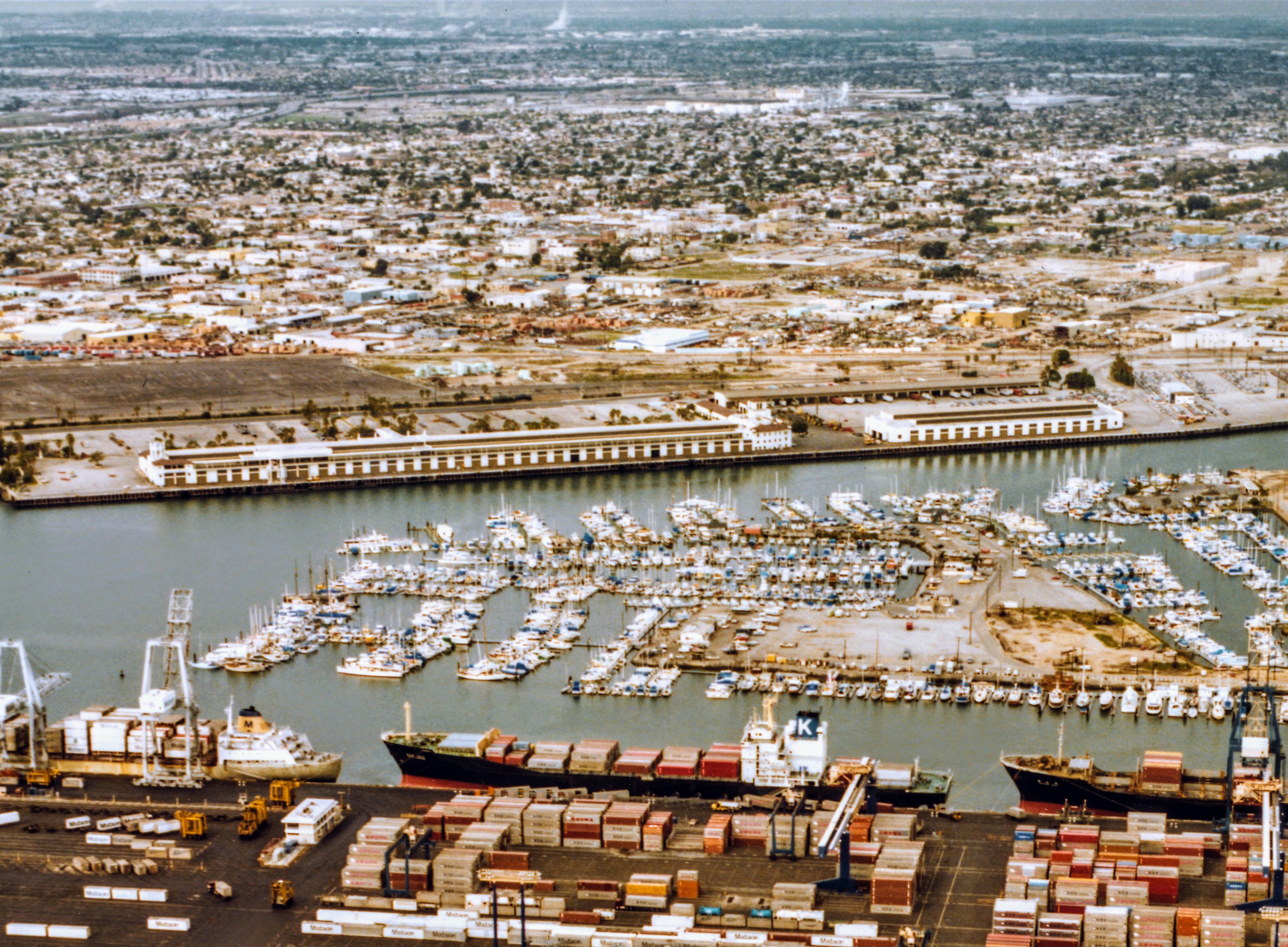
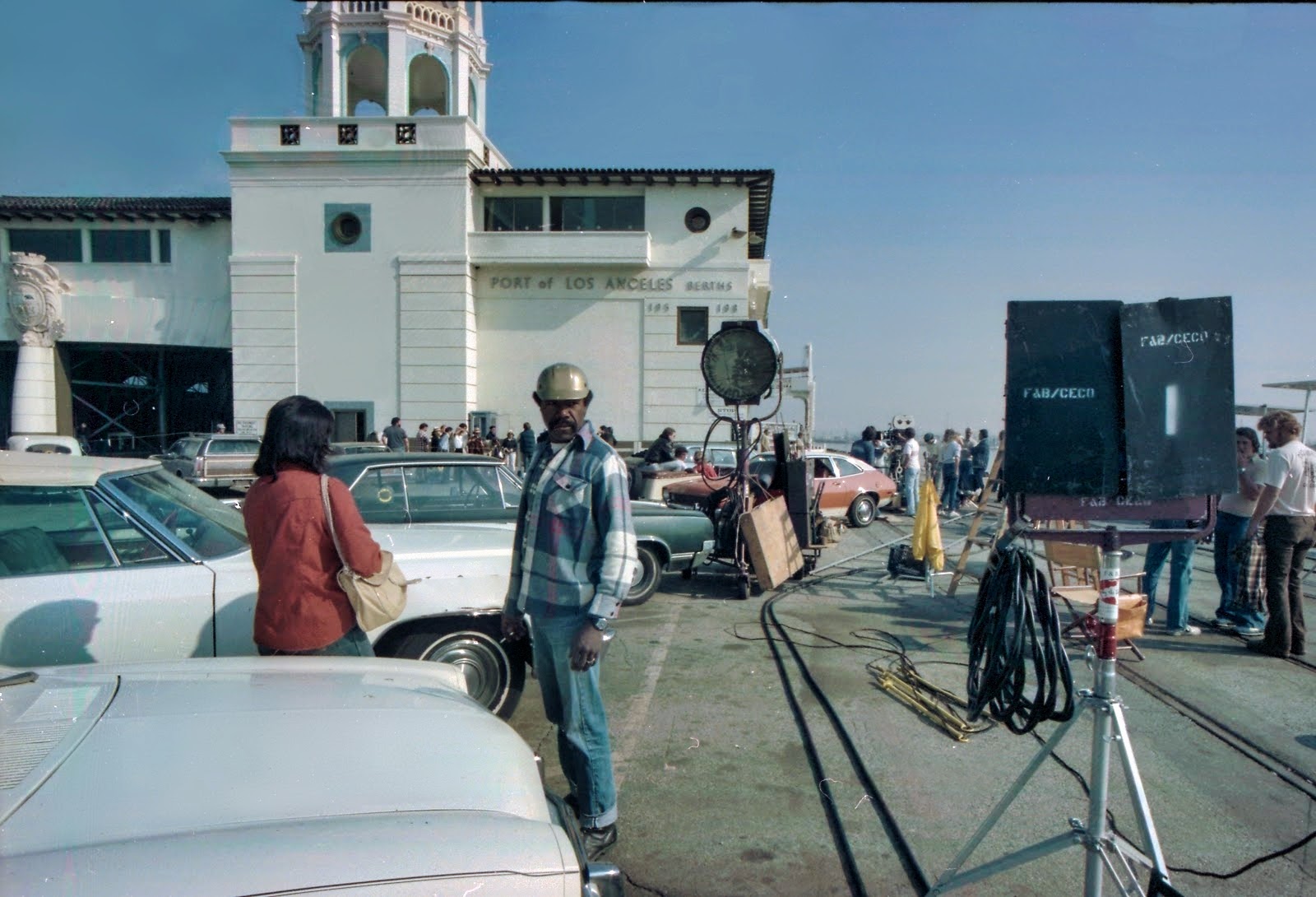
The terminal wasn't completely empty after Matson vacated the property but it wasn't exactly thriving either. The building was repainted white sometime in the 1970s in an attempt to make it more appealing to prospective tenants but, in doing so, the last connection to the Royal Hawaiian was brutally severed. For what it was worth, the Harbor Department sought out new tenants but there was never a formal "official" occupant of the building. The terminal would host (mostly) European passenger ships that made stops in Los Angeles and was occasionally utilized for television and commercial film shoots, but it remained mostly empty throughout much of the 1970s and early 1980s. The last reported "event" at the Matson Terminal was in May 1984 when European company Sitmar Cruises christened a vessel, The Fairsky. The Harbor Department's focus on the San Pedro waterfront as the hub of commercial activity (through retail ventures such as Ports O'Call, Princess Louise Restaurant, etc.) meant that the APL World Cruise Terminal in San Pedro would emerge as the primary terminal at the Port of Los Angeles. This is confirmed by a San Pedro News Pilot report that explained that the last two companies that utilized the Matson Terminal for periodic passenger services, Sitmar and Royal Viking, had been redirected from the Matson Terminal to the World Cruise Terminal. In 1984, the final blow came when Mayor Tom Bradley appointed a new Executive Director at the Harbor Department. As history has proven time and again, commerce-minded politicians have been the death knell to many old buildings throughout Los Angeles, and this case was no exception. The new leadership evidently viewed the Matson Terminal as nothing more than a white elephant occupying valuable waterfront property, and by the end of 1985, the Matson Terminal was formally on the chopping block.
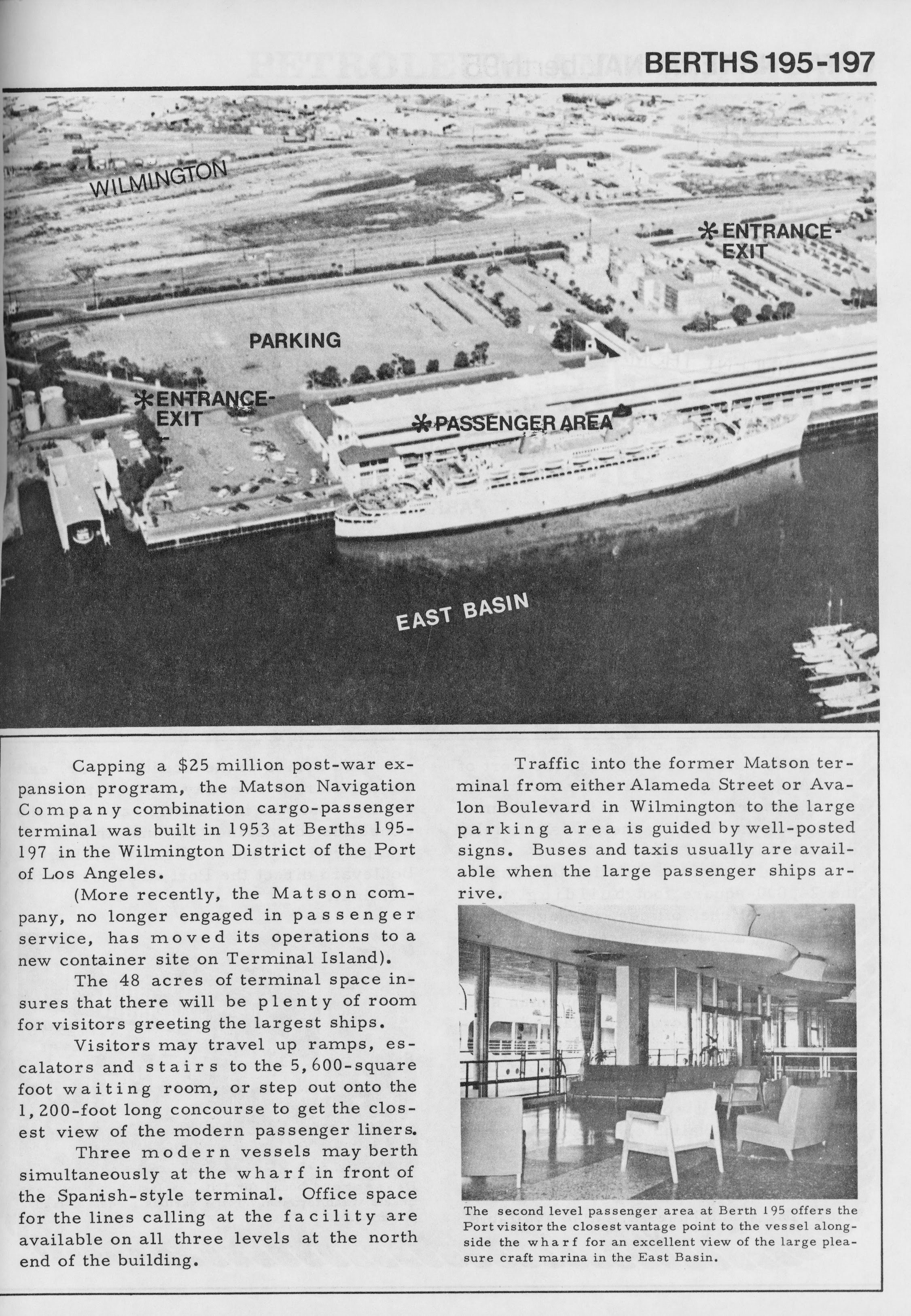
There wasn't much press decrying the impending plight of the terminal save for one inquisitive reporter at the San Pedro News Pilot named Teresa Simons. In a front-page article written for the News Pilot on February 10, 1986, Simons challenged the lunacy of destroying what had been considered a collective triumph and lamented that "a glamorous era in Los Angeles Harbor History is being uprooted, shaken, and crushed into dust to make way for an auto terminal and hardly anyone seems to notice." Even 30 years after its golden age, Simons had no trouble using adjectives like "elegant" to describe the terminal and summarizing it as a "masterpiece." Though Matson had been long gone from the building, Simons spoke to Matson's public relations director, who was more than happy to talk about the terminal and acknowledged that the loss of the building was indeed a tragic event. He recounted to Simons a number of high-profile personalities that had passed through the terminal in its heyday, including actor Gordon MacRae, Ronald & Nancy Reagan, Walt Disney, and Elvis Presley (with manager Colonel Parker in tow). Simons also contacted the Harbor Department and spoke to the Assistant Chief Engineer, Joe Thomas, about the destruction of the terminal. In a rather ironic twist, Thomas had actually helped to create the Matson Terminal, serving as a draftsman for the Harbor Department under Burgo Purcell. He told Simons that the interior of the building had already been gutted, and the shell of the building was slated to be torn down later that week to make way for the auto yard. Simons reported that he offered a shrug and downtrodden response of "that's progress," yet she was quick to note that with that half-hearted response, he "didn't seem like he could even convince himself." The terminal was razed completely by Valentine's Day. On March 6, nearly three weeks after the fact, the Los Angeles Times reported the terminal's demolition by running before and after photos in its South Bay section of the paper. The caption included a quote from a Harbor Department spokesman who stated that the terminal "was quite a beautiful thing during its time."

Though the terminal is gone, remnants of it can still be seen throughout the Wilmington waterfront. The Los Angeles Maritime Law Enforcement Training Center sits (more or less) where the public entrance to the terminal was while WWL Vehicle Services America occupies what was the parking lot and helipad. The streets leading to where the terminal was located remain (relatively) untouched. The planter that served as a roundabout for drivers remains in front of the training center, and the "fin" lights leading to the entrance are still along what was once called Matsonia Way (later renamed Nissan Way/Yacht Street). Fragments of the wrought iron and glass statuary erected along the median can still be seen throughout, but the ravages of time have diminished them and taken much of the glass with it. The iron pineapple that sat on top of the statue is also long gone. The decorative urns found throughout the property, however, have a slightly more intriguing story surrounding them.
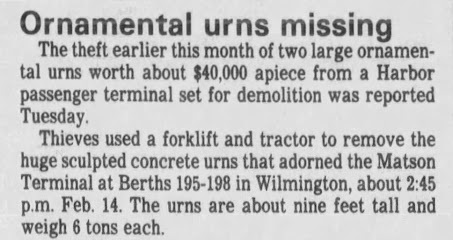
A few days after Teresa Simon's article was published in the News Pilot, the paper reported that two of the 9-foot, 6-ton concrete urns that surrounded the waterfront near the terminal went missing. They were reported to have been taken by a man who claimed he was hired by the Harbor Department to "take away" the urns which were estimated to be worth $40,000 each. There was no follow-up report to relay if the urns had been found, but at least one of the two "missing" urns, somehow ended up in the park area directly in front of the Municipal Building in San Pedro although the base of that urn is either missing or has been buried below ground. Two urns remain in Wilmington. One urn and most of the balustrade remain where they were originally situated, while a second urn was relocated in 2010 to the Port of Los Angeles Archives building on Fries Avenue (the former diving school) but the urn was irreparably damaged when Harbor Department employees drilled holes through the base in order to move the urn. The director of the archives (now closed) referred to the damage as "a curatorial nightmare." Though the holes were patched, the damage is still evident more than a decade later. No word about the second missing urn but my guess is that it was less of a "theft" and more of a "rescue." Locals are proud of their history and have had to save more than one artifact from the indifference of commercial redevelopment.
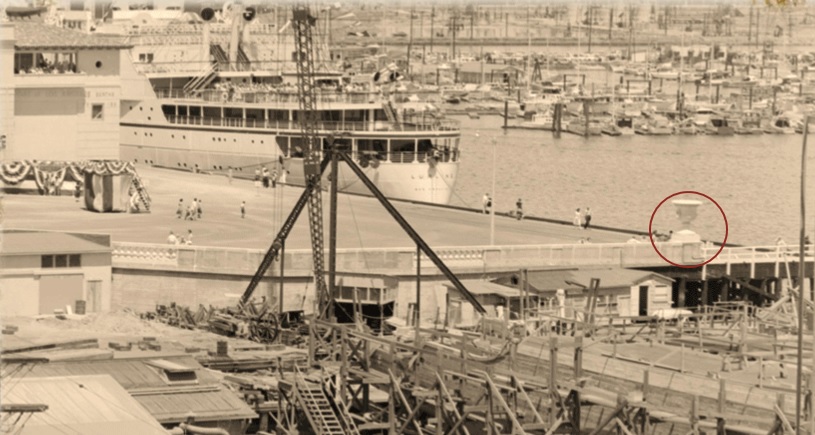
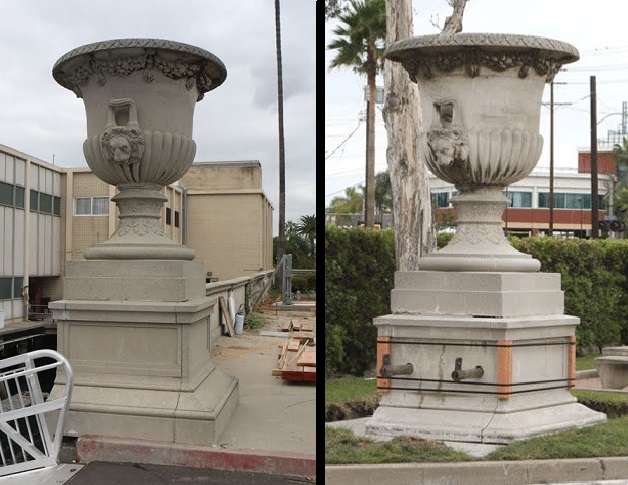
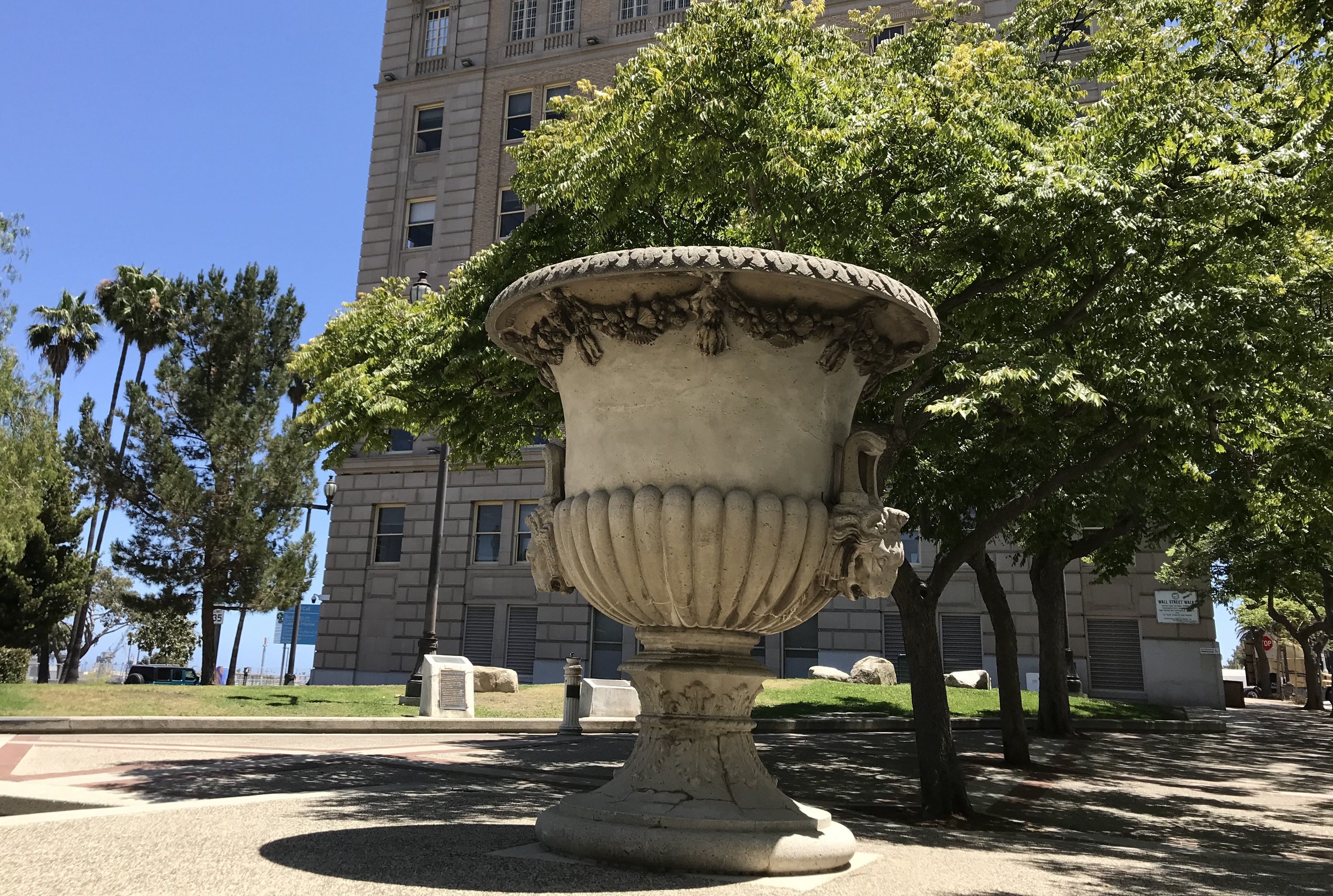
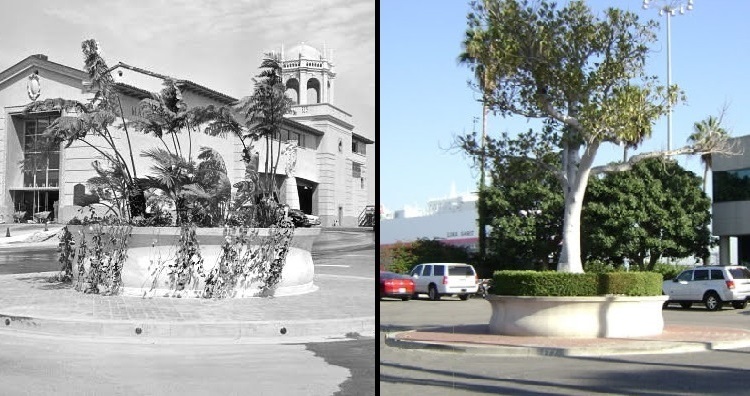
Perhaps the most lasting contribution that the Matson Terminal made to the L.A. Waterfront was the fin-shaped lights that capped the cement pillars leading to the terminal. As part of a waterfront revitalization project, the lights were replicated, and the reproductions have been dispersed throughout the Wilmington and San Pedro waterfront for more widespread public consumption. The company that recreated the lights christened them "Angel Lights" as the fins resemble wings and have nautical elements frosted onto the glass. They really are beautiful and now have a name that is much more befitting of lights that illuminate Los Angeles Harbor.
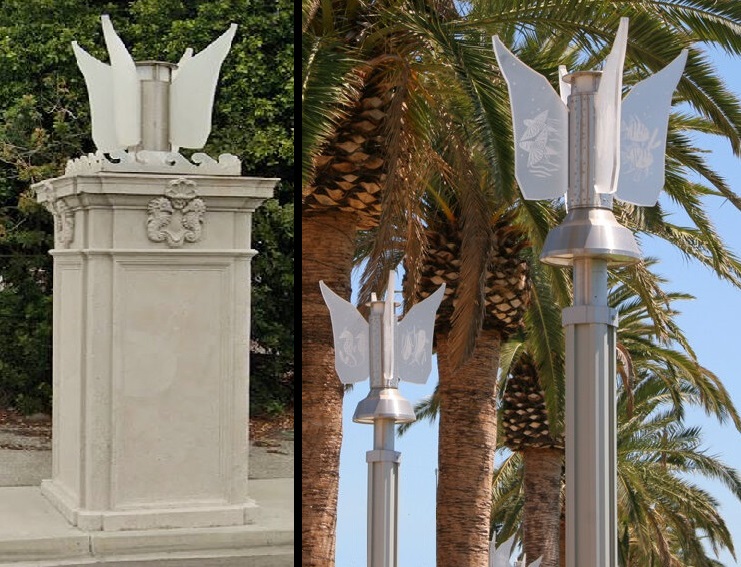
The Matson terminal belonged to an age of extravagance that is now long gone. Once the most prominent economic partnership between Los Angeles and Hawaii, the terminal, once known as the "world's finest," became a white elephant blocking the path to progress when it was no longer economically viable. When it was unceremoniously razed in 1986, Los Angeles lost yet another architectural marvel that made our city unique. The Matson Terminal ultimately fell victim to the kind of short-term memory about our history and architectural heritage that, even to this day, continues to allow Los Angeles landmarks to be lost.
—Sincere thanks to both Tiffney Sanford (lalibrarytour on Twitter & Instagram) and Dennis Johnson (Ah_Pook on Flickr) for allowing the use of images from their private collections.
